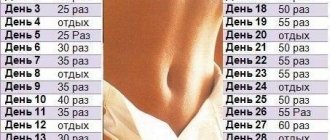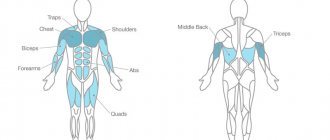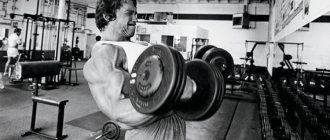If you don't want to read, listen. (read by robot)
When you come to the gym, you will see that some students have notebooks with them and often write something down there. They are the ones who keep a training diary. Without a training diary, progress is reduced by forty percent. Do you want to do half-wasted work?
You can take your training diary almost anywhere. You can make notches on a piece of wood. Mark with chalk on the wall and tie a string in knots accordingly. Joke
In fact, when people do this, they keep a kind of training diary. Arnold did exactly the same thing when he came to an abandoned factory where there was an abandoned gym. He took chalk with him. Imagine: you don’t need to carry a book with you, not a cell phone, not a tablet, and other methods of communication. I just put a piece of chalk in my pocket, that's the whole diary.
Well, during training he made his notes on the wall. He indicated how many approaches he did. How many exercises to avoid getting lost? Sometimes you forget, for example, what the third or fourth approach was. How many complete approaches did he complete, how many did he not complete, and so on.
I saw a guy who also wrote on the wall with chalk all the time. His name is Volodya. Well, of course, healthy and pumped up. My personal opinion: you need to keep both a training diary and a nutrition diary. Then you can figure out the training and understand what and where is wrong.
One day I decided to look at my old diary entries. And I found the place where I was preparing to take my personal record, namely to squat 150 kg. I trained specifically to get to this weight. And on the day of the Record, I discovered that I did not squat 150 kg. Started to remember why? The muscles were prepared. By all accounts, I should have done this. Still, I remembered. It turns out that day I had a bilateral sore throat, and I was sorry to waste preparatory time. I decided to squat 150 kilograms.
I thought the sore throat was no big deal, I’d get over it somehow. But it turned out that the elevated temperature and weakening of the body by toxic berries did their job. I was able to sit down. But the guys who were belaying me lifted me up.
The conclusion suggests itself. You need to exercise without acute illnesses. And chronic diseases should be in remission (not aggravated).
A diary is a thick notebook in which you will write down everything related to training. This includes a set of exercises, in which not only the exercises will be recorded in the diary, but you will also note how many approaches you did in the exercise, how many repetitions, with what weight this work was done. You will make notes in your diary after each approach. On bodybuilding .
In the diary, as I already said, you can write down everything related to training: about nutrition, rest, additional load, mood, etc. "For what?" - you ask.
For many reasons:
First: recordings will organize you. To make a recording, you need to study.
Second: feedback. When you have practiced and looked at what you have done. You are filled with self-esteem. That's how good I am, how fruitfully I worked out today.
Third, and this is the most important thing, after looking at your notes, the trainer can adjust your training.
And fourth. Over time, you will learn to independently analyze your training, and you will write out sets of exercises for yourself.
Personal training
How to use a diary, how to keep it? There are many ways to keep a training diary, because there is no single system. The simplest option:
We take a thick notebook (the thicker the better), you can even take a diary. And a pen. We write the header: Date, month, day of the week. Below we write the name of the exercise and after each approach we note: what is the number of the approach, with what weight was it done, how many repetitions (times) were performed in this approach.
Let me explain right away:
What is approach and repetition in sports.
– You approached the projectile, did it 10 times and walked away. You did one approach. We came up, did 8 more times, this is the second approach, etc.
Rest up to 5 minutes between sets to properly recover for the next set.
You cannot rest for more than 7 minutes , the muscles cool down and additional warm-up approaches may be required.
What is repetition?
– this is how many times you did it in one approach. For example, you did it 12 times. This is you doing 12 repetitions in one approach.
In other words:
Repetition is performing an exercise once from the starting position to the final position.
A continuous series of repetitions is called a set.
Example of keeping a diary:
1. Press: 15; 10; 8;
From this recording it is clear that the student performed the abdominal exercise in the first approach 15 times, in the second 10 times and, completely tired, did it 8 times. Take any other exercise. But here we already have kilograms in our records.
2. ZhL (barbell bench press): 80kg/8 times; 80/8; 80/7;80/4
Looking at this recording, we understand that the person lifted a barbell weighing 80 kilograms, he performed the first approach for 8 repetitions (times), the second for 8, the third for 7 and the fourth for 4 times.
We can immediately make a reservation: there are countless different methods and methods of training. And sometimes it is very difficult for a beginner to figure out how he should train? Some athletes advise doing five sets of five repetitions, others – four of ten, others three of fifteen, and there are also those who say that you need to do at least thirty repetitions in one approach!!! So who should you listen to? Usually this understanding occurs gradually. It takes about six months for you to begin to understand what's what. Example : A girl came to my gym - she was short and thin. As she joked: “I buy my clothes from the children’s world.” She, unlike most girls who want to lose weight, wanted to pump up. To look more respectable. Gain mass.
But at first, our usual set of training, which suits most girls, gave a negative result. She lost even more weight.
And then she and I began to select a set of exercises that would suit her. And over time they found him. The 5*5 (five by five) system suited her. Five sets of five repetitions per exercise. And, using this system, she successfully gained the mass she needed.
And further. Beginners do not need to use heavy weights right away. The weight should be such that you can lift it 15 times. Not less. If you cannot lift the weight more than 14 times (for beginners, or a new exercise for you), this indicates that the weight is too heavy for you. And there is a possibility of damaging the ligaments. A damaged (strained) ligament takes months to heal. So think about whether the excessive haste is worth it. The proposed training method is simple and understandable. Very good for a beginner. After you have decided on the exercises. Choose which exercises you will do on which training day. You need to determine how many approaches you will do in this exercise, how many repetitions to do in one approach, and choose the working weight of the projectile for yourself.
Here's a great journal from a new student of mine.
Freeletics Bodyweight - training and fitness
An application with an optimal set of functions, clear demonstration of exercises and well-designed workouts and modes for beginners and experienced athletes. But - there is no Russian language, although the navigation is made quite simply, which makes using the application somewhat easier. Advantages:
– many training programs;
– Health Kit support (“Health”); – attractive design; – the ability to download videos of only individual exercises; – presence of a section with useful articles; – lack of advertising materials; – availability of a food diary; – availability of a training program with the ability to customize; – competent description of exercises. Disadvantages:
– the need for authorization at the first start; – lack of Russification; – inability to create your own workout; – inability to accommodate people with disabilities.
How to determine how many approaches you need to do in an exercise?
And how to start so that the muscles don’t hurt.
Very often you can see such a picture in the hall. A beginner comes and, with his characteristic tenacity, actively (very actively) studies. The next day he cannot move without pain. All the worked muscles hurt a lot.
Especially, for some reason, beginners train their abs intensively. They “pump him up” so much that even then, after a few days, they can’t touch his abs. The abdominal muscles work little in everyday life and therefore respond very strongly to the load. They need to start training in a particularly gentle manner.
One woman was even injured. I came to the second training session and, through the pain, began to do abdominal exercises. At the same time, I received terrible pain and micro-tears in the abdominal muscles. She did not appear in the hall again. Of course, who would want to mock themselves like that?
Therefore, I suggest not to overdo it, especially since there is nowhere to rush. If you are just starting to exercise, or doing a new exercise, or came to the gym after a long break, then start small.
It is best to do two approaches with a light or medium weight for you. A light weight is a weight that you can do 15 reps with. If you can’t do 15 repetitions, but you get less, you don’t have enough strength for 15 repetitions, this means that the weight is too much for you. To start, set the weight lower. Do two sets and see how your muscles respond to this training. If by the next lesson the muscles do not hurt (or hurt just a little), then it is best to first accustom the muscles to such a load. And only then, after several workouts, add the next approach.
Conclusion
A diary is needed in the first place, where there is more technology and less creativity or art. At first, you can help your child manage it. Teach the young athlete to the idea that a diary is an integral part of professionals. And also to the fact that a day spent doing an exhausting workout, but without recorded indicators, is a lost day.
If the child is very tired, it won’t be a crime to fill it yourself once or twice. Let the diary become the athlete's personal space where he can vent his anger, record an observation or his emotions that are difficult to share. Thus, the diary will provide you with a serious psychological service.
And what is working weight, and how to select it?
The fact is that an untrained person’s ligaments and muscles are naturally weaker than those of a trained person. But even beginners can have completely different physical preparation. One beginner can lift much heavier weights than another less trained one. Therefore, for each person the weight of the lifted projectile will be different.
Working weight is the weight with which you will train, i.e. work. This value is not constant. Depending on the tasks assigned, it may change. The first two months you need to use a machine (or a barbell, or take dumbbells) with a relatively light weight.
It's best to have a weight that you can barely complete 15 reps with. I did it 15 times, but couldn’t do it the 16th time. This small weight will protect you from unplanned injuries.
Imagine if you put a weight on the apparatus that you can hardly lift 6 times, and even do 4-6 approaches! If you're not used to it, you can seriously injure your muscles and ligaments. And painful sensations are guaranteed for at least a week. Why bother so much at first?
Therefore, we take a relatively light weight with which we can perform the exercise 15 times, and do two sets of 15 repetitions. And at the next training session we look at how we feel.
If the muscles hurt badly, then there is no need to force them, they have not yet recovered. Skip this exercise until your next workout.
And if they don’t hurt or hurt slightly, then you can work out, also doing two sets of 15 repetitions. And only when muscle pain does not bother you at all can you add the next third approach.
I also want to say a few words in favor of a small working weight for beginners. Starting to study
is very important to perform the exercises correctly . Learn to do them technically correctly.
Because an incorrectly performed exercise is fraught with a lot of trouble. Starting from the fact that it is possible to get injured and doing the exercise incorrectly, you are not training the muscles that you think are working for you.
to purchase the necessary equipment.
With a lot of weight, you will end up with distortions and imperfections or under swing (cheating), which is unacceptable for a beginner. And an incorrect movement stereotype will be developed. And relearning later is much more difficult than learning correctly right away.
It is quite difficult to explain all the movements in each exercise in words. Therefore, I created a video: “Exercise Art,” in which I fully explain how to perform various exercises technically correctly.
Moreover, despite its apparent simplicity, each exercise has its own nuances. And knowing them, you will get much greater returns from your training.
Fitness workouts from Runtastic
One of the most popular fitness apps in the gym. Designed for advanced users. It has a rich reference book of exercises, which can be supplemented with its own exercises. It is possible to purchase ready-made training programs and advanced capabilities for maintaining training process statistics. Advantages:
– video for each exercise with tips on how to perform it;
– division of exercises by type (basic, advanced, professional); – photo diary; – the ability to exclude “noisy” exercises; – many ready-made training programs; – support for Health Kit and iMessage; – availability of a training program with the ability to customize; – a high degree of scientific explanation of the exercises. Disadvantages:
– heavy weight of the application; – mandatory authorization; – inability to plan a workout; – inability to add an exercise or workout to favorites; – impossibility of deleting downloaded video materials.
Warm-up before exercise:
In addition to the general warm-up that you did before training (running, cycling, etc.). The general warm-up lasts 5-10 minutes. until light perspiration. A must do
a special warm-up for exactly the exercise you are going to perform. For example: if you are going to do a bench press on a machine while sitting, then you do not immediately do the bench press with a heavy (working) weight, but take a small weight for the first approach, such that you can perform the exercise 15 times and do a warm-up approach.
In order to warm up exactly those muscles that will work in this exercise. This is a special warm-up.
And do this warm-up immediately before each exercise. If you feel that after the first warm-up set you have not warmed up properly, then do a second warm-up set.
This is not an unnecessary precaution, this way you will protect your muscles and ligaments from sprains and damage. And the pulled ligament takes more than a month to heal.
Sprains are dangerous because the ligaments do not immediately hurt. Ligaments hurt the next day after training. And during class you don’t feel any pain. And remember an important rule:
If you experience any pain during the approach, do not complete the approach, stop the exercise immediately.
And if you have a little pain in some muscle (this means pain of a traumatic nature, and not after the first training). Then you need to wait until the pain goes away and not do exercises on this muscle. Otherwise, with every workout, a sore muscle (or ligament). will become more and more injured.
But that is not all. You need to somehow progress in the exercise. That is, constantly improve your results. Either lift a given weight several times more, or gradually increase the weight itself, or add one or more approaches. Etc.
Let me make a reservation right away: it is impossible to constantly progress (with conventional complexes). Therefore, training takes place in waves. Cyclic programs are used.
The load gradually increases, reaches a certain limit, then a rest from the exercise equipment is taken, then we start with a lower load and repeat the cycle.
According to the principle of three steps forward, one step back. But this is true for advanced practitioners who have trained for at least a year.
For beginners, I suggest the following journaling scheme.
Let's look at the diagram for any exercise that is done with weights. It doesn't matter what kind of exercise it is. The scheme is equally suitable for both beginner men (boys) and beginner women (girls).
There will only be different numbers for the weight of the apparatus and the number of repetitions for different people. But the meaning is the same.
Let's take, for example, the bench press exercise. Let's say you have determined your working (training) weight to be 30 kilograms. That is, you can press a barbell weighing 30 kilograms for 10 repetitions (10 times). You may need to do not 10, but 15 or 8 repetitions.
Now this is not important to us. The main thing is to understand the methodology. We write in our diary:
ZhL 30/10 on top we write 30 kilograms, on the bottom the number of repetitions (times) is 10. 30kg/10 times
And for you, according to the set of exercises compiled for you, for example, you need to do 3 sets of 10 repetitions (3*10) on the bench press.
After a short rest, we do the second approach. The muscles are already tired after the first approach, and will lift this weight fewer times. Our entry will look like this:
ZhL 30/10; 30/8
The second approach you completed only 8 repetitions. And the third approach will look, for example, like this:
ZhL 30/10; 30/8; 30/6
The muscles were even more tired. It’s great when such a record appears, you can start working productively with it.
After this workout (do not think that this is the whole workout, this is just one exercise shown).
Your task is to rest properly and restore your muscles for the next workout.
After all, a muscle grows when it rests, and not when it works (when a muscle works, it simply “inflates”).
The next day of bench press training arrived. You have properly restored your muscles. They are rested and efficient, “eager to go into battle.”
And the diary entry looks like this:
ZhL 30/10; 30/9; 30/7
You see: You improved your result in the second approach by only one time. And in the third one on one.
But you set a new personal record. And now, as you probably already guessed, you will need to gradually, over and over again, bring all three approaches to ten repetitions.
And then you write in your diary:
ZhL 30/10; 30/10; 30/10
Congratulations, you have completed the task assigned to you. Let me remind you that we had to do three sets of ten repetitions of 3*10. Now there is no point in doing 3 sets of 10 reps with a weight of 30 kg for the rest of your life.
But many people do just that. We need to progress, move on. How? It all depends on the task at hand. Someone wants to increase strength and muscle size.
Someone needs to lose weight, etc. I will create a training program for you.
I’ll show you how you can vary our achieved result:
You can add weight: put 32kg: ZhL 32/10. Or increase the number of repetitions to 15 times: 30/15, you can add one or more approaches
30/10; 30/10; 30/10 + 30/10 + 30/10
You can also reduce the weight, you can also reduce the number of repetitions, and you can also reduce the number of approaches. Everything depends on our task.
Do you see how varied the exercise can be? And this is only one exercise, and there are many of them in the training complex. I'll show you what entries in a diary look like. There can be many spelling options. Here is one of them:
21/06/Mon. Date/month/day of week
1. Press: 15; 12; 10; 8
2. VNS (leg straightening while sitting on a machine): 30/15; 30/15; 30/12; 30/10
3. SNL (lying leg curl on a machine): 15/15; 12/15; 12/15; 15/6
4. ZhtrS (press, sitting on a machine) or it could be 40/12; 40/10; 40/8; 40/6 4a. ZHL (bench press)
Etc.
There is no need to write a detailed description of the exercise in your diary every time, an abbreviation is enough. The main thing is that you and your mentor understand what kind of exercise this is written.
Then the recording turns out to be quite small. And making notes in your diary after each approach is not at all difficult.
How many exercises to do in one workout?
There are many opinions on this matter. And before, and even to this day, it is often found that instructors describe a set of 8-12 exercises per workout, and even 4-6 approaches in each!!
This is too much for the common man. With this approach to business, a person will work for wear and tear. Over time, he will lose interest in training and quit.
I’ll tell you where such a huge number of exercises per workout came from. This all comes from bodybuilders. Guys who “ate” a large amount of anabolic steroids become five times more efficient than an ordinary person. And they can spend up to three hours in the gym for one workout.
An ordinary person has nothing to do in the gym for more than one hour. During this time, he will have time to do no more than five exercises, or even less. You need to train in the gym for no more than an hour and do three to six exercises during this time!
Don't train one muscle group three times a week!
A training diary is not some mythical purchased diary, but simply a technique for systematizing classes.
The training diary itself is a means of recording the results of the exercises. Usually they write in it:
- Training date.
- Exercises included in the workout.
- Number of repetitions and approaches.
- Working weights.
- Rest time between sets (not always, only if it is important).
- Anthropometry (not always, but it is useful to do this periodically to track progress).
- Additional notes and comments.
- Meals, their composition (BJU) and calorie content (not always, but will be useful when gaining weight and cutting).
The combination of these factors makes it possible to determine the further vector of development; in addition, the training diary is useful in the event of a change of trainer/gym. In particular, it allows a new trainer to determine the dynamics of your development and more accurately select a new training program in accordance with your progress.
Who should keep a diary?
A diary should first of all be kept by someone who needs sport as the meaning of life and who is completely passionate about it - an athlete. A diary not only helps you understand yourself, but also characterizes you as a professional. Reveals our strengths and weaknesses. And it shows that success came deservedly, and not fortunately.
Keeping a diary is often beyond the capabilities of little athletes 4-6 years old, so you can do it for him, teaching him from early childhood that this is normal. At 8-11 years old, a child can be helped with discussion and advice. But in adolescence, a child must gain independence. Now the young athlete himself knows how, how many exercises he has done. And your interference can be annoying.
The athlete's diary can be kept by the head coach or his assistant. If you play a team sport, remember that each player must develop individually. The coach will be able to characterize you not just as an athlete, but also as a player on the team. After all, feedback is a very valuable achievement. The developed methodological base will help improve your efficiency when moving to another coach or team.
Football coach Viktor Zakharov recalls the beginning of his coaching career: “On the advice of Konstantin Ivanovich Beskov (the legendary Soviet football coach), I kept diaries and journals where I described who played, what positions, substitutions and mistakes.”
How to do it?
How to make a workout diary at home? Everything is very simple. It is enough to have a thick notebook or notepad and pen on hand. The following should be entered in the diary:
- On the first page there are current anthropometric data.
- On the following pages, record the results of the training - exercises, approaches, repetitions and working weights. If nutrition is important, allocate space for it.
- Each page should be filled with pre-planned exercises, and during training or immediately after it, only numbers should be entered.
- On the last page (when the number of pages comes to an end) - write down new anthropometric data. Or do it periodically, for example every month.
Depending on the type of profiling of the athlete’s loads, different training diaries are created. A classic training diary involves recording only your results, and you can keep it without outside help right during the lesson.
More complex options involve the need to measure anthropometric data, record time work using a timer, and a huge number of related factors. Such a training diary is often redundant for amateur athletes, but is extremely necessary for professional athletes (for example, bodybuilders, who must remember not only the number of repetitions and weights, but also ensure that the body responds correctly to a new type of training in the long term).
The main essence of the diary
The main essence of the diary is the development of the “athlete’s mindset.” At large competitions, where the speeds are lightning fast, where the coach cannot be physically nearby throughout the entire distance, it is very important to make decisions faster than yourself, and your opponents, and most importantly, independently.
After the performance, the athlete and coach will be able to discuss the acute situation and come to the right tactics. An athlete must trust his coach. However, sometimes he can come to a decision faster than a mentor intuitively or by analyzing the game while being in it directly. This defines true champions.
Valery Lobanovsky said: “That the effectiveness of any technical and tactical exercise is determined by four factors: duration, intensity, number of repetitions and rest pause.”
It's hard to keep that kind of data in mind. And it’s easy to forget the indicators from a week ago. In order not to exercise stupidly, you need to keep a diary. It shows that you are serious and focused on winning.
This is what Aleksey Khokhlov, a student at the Youth Sports School who plays football, says about the diary: “The diary helps me concentrate. I look at where I could improve further or show the maximum of my capabilities. I don’t feel my capabilities, but I see them in practice.”











